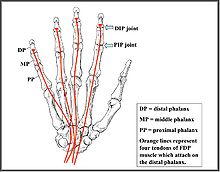- Jersey Finger
-
Hand and finger injuries are extremely common and often described in colorful terms.
Contents
Anatomy
All four non-thumb digits (index finger, middle finger, ring finger and little finger) contain three bones called the phalanges that are aligned in a linear row like box cars in a train. These bones are designated the proximal phalanx (closest to the palm), the middle phalanx and the distal phalanx (furthest from the palm). The joints between these bones are referred to as the proximal interphalangeal joint (PIP, between the proximal and middle phalanx) and the distal interphalangeal joint (DIP, between the middle and distal phalanx). Large muscles in the forearm send long tendons to the fingers and these tendons attach at specific points on these bones. Flexing and extending these digits occurs when these muscles contract and their tendons pull on their bony attachments. The deepest of the flexor muscles in the anterior forearm is called the flexor digitorum profundus muscle (FDP); it gives off four tendons that travel through the carpal tunnel into the hand and attach to the distal phalanx in each of the four non-thumb digits.
Jersey Finger Injury
Jersey finger is a term used to describe an injury to an FDP tendon at its point of attachment to the distal phalanx. This injury often occurs in American football when a player grabs another player's jersey with the tips of one or more fingers while that player is pulling or running away.[1] The force of this action hyperextends the tip of the finger at the DIP joint while the proximal portion of the finger is flexed. This action can partially or completely rupture the FDP tendon at or near its attachment point on the distal phalanx. Sometimes, the force is great enough to pull off or avulse a piece of phalangeal bone to which the tendon can remain attached. The torn FDP tendon can retract slightly, remaining in the finger near the PIP joint, or can retract more fully into the palm of the hand. A person who suffers a jersey finger injury in which the FDP tendon is completely ruptured cannot flex the affected digit at the DIP joint without assistance.
Symptoms include:
- A pop or rip felt in the finger at the time of the injury
- Pain when moving the injured finger and the inability to bend the last joint
- Tenderness, swelling and warmth of the injured finger
- Bruising after 48 hours
- Occasionally a lump felt in the palm of the finger[2]
Treatment
Type I injuries (partial rupture of the tendon) can be treated without surgery with rest, ice and elevation. A finger splint is often used to hold the digit in place until healed. Type II (full tendon rupture) and Type III (rupture with bone chip attached) require surgery to repair the soft tissue damage. Often, surgical pins are inserted into the injured digit to stabilize the bone and tendon in their proper alignment. [1] Post surgical complications can include infection, pin failure and nail and joint deformity.
References
- ^ Wang, Quincy C., MD, and Johnson, Brett A., MD. Fingertip Injuries. American Family Physician. May 15, 2001. Vol. 63, Number 10. Pp. 1961-1966.
- ^ Tuttle, Harrison G., MD, et al. Tendon Avultion Injuries of the Distal Phalanx. Clinical Orthopaedics and Related Research. April 2006. No. 445. Pp. 157-168.
External links
Categories:
Wikimedia Foundation. 2010.

